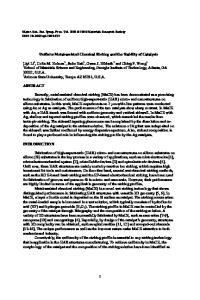Copper Etching: New Chemical Approaches
- PDF / 1,687,574 Bytes
- 7 Pages / 576 x 777.6 pts Page_size
- 56 Downloads / 307 Views
Copper Etching: New Chemical Approaches Mark J. Hampden-Smith and Toivo T. Kodas
Copper Film Patterning Processes
Introduction
Motivation For Interest in Cu There is a tremendous demand for improved performance and speed in consumer electronics that is likely to continue as new applications and developments occur. This demand necessitates a reduction in the critical dimensions and an increase in the density of devices in microelectronic circuits.1'2 As a result, new materials must be considered for integration into microelectronics technology. In particular, the metal wiring or interconnects that connect different components in silicon-based semiconductor devices is a subject of great interest. As the dimensions of transistors shrink below the 0.5 /am level, their speed will become limited by the delays in the existing interconnect material, Al-Si-Cu alloy (p ~ 3 fiH cm). Therefore, to avoid problems associated with RC ("resistance/ capacitance") time delays and voltage drops, it will be necessary to construct interconnections of materials that possess lower resistivities, resistance to electromigration and hillock formation, and resistance to diffusion into other materials (see Table I). A number of materials are possible candidates to replace the Al-Si-Cu alloy, including W, Ag, Au, and Cu.3"5 Tungsten has excellent resistance to electromigration and hillock formation, but has higher resistivity compared with the Al-Si-Cu alloy. Thus, applications of W are likely to be found where short interconnection distances are necessary. Silver has the lowest resistivity of all metals, but is easily corroded and diffuses rapidly into many materials used in semiconductor devices. However, some specific applications for silver are viable, such as the formation of contacts on ceramic superconductors. Gold has a lower resistivity than the Al-Si-Cu alloy and is inert to chemical corrosion. As a result Au is used where device reliability is the primary concern—for example, for wiring in GaAs-based semiconductors and
MRS BULLETIN/JUNE 1993
electrical contacts in packaging. Copper has a lower resistivity than the Al-Si-Cu alloy.6 For this reason, copper is currently used as the metallization material on polymer substrates such as Poly(tetrafluoroethylene), also known as Teflon®, and is the basis for the printed wiring board industry.7 In the past, however, it has not been used in microelectronics applications because it oxidizes relatively easily and it exhibits some materials compatibility problems with materials typically used in integrated circuits; such problems include having high diffusion coefficients in both Si and SiCV8 As a result of continuing advances in diffusion barrier technologies,910 however, copper metallization schemes are being considered for future applications in microelectronic devices. For these applications, it is necessary to form patterned copper films. Furthermore, as a result of the interest in Cu metallization, there have been many studies of the deposition of Cu films by chemical vapor deposition
Data Loading...











